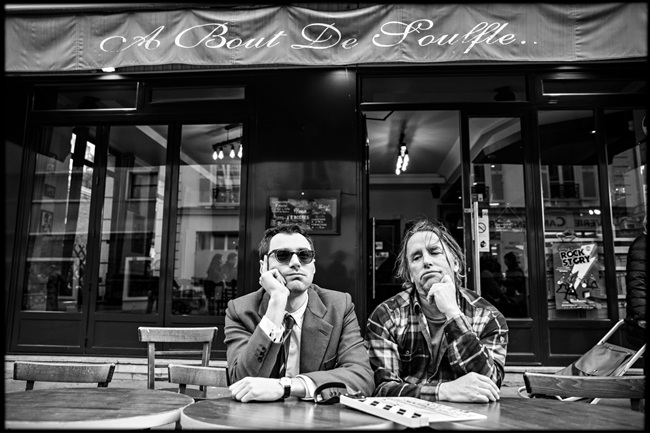New Rendering of Classic French Godard Film “Breathless”
It’s a brave, bold move for an American director to put their hands on a French classic, which is precisely what director Richard Linklater did with Nouvelle Vague, and the risk paid off. Jean-Luc Godard changed cinema with his iconic New Wave film Breathless (in French, titled À bout de souffle), and it remains a classic for cinema lovers and filmmakers as emblematic of a new style of the art.
The crime romance film Breathless, starring Jean-Paul Belmondo and Jean Seberg, broke ground with its bold and unusual style, jump cuts, and unconventional editing. Classic and revered as it may be, it’s – like many works of art – an imperfect creation. Over time, the film has been criticized for the chauvinism shown by the film’s protagonist, Michel (Belmondo).

Jean-Luc Godard at Berkeley, 1968. Photo: Gary Soup / Wikimedia Commons
Imperfections aside, the classic beckoned Linklater to take a closer look at a fresh perspective. In Nouvelle Vague, which is shot entirely in black in white, we see the filming of the movie, a peek behind the director’s curtain. Godard (Guillaume Marbeck) is maddening to his actors. The film, we learn, uses voiceover recordings, so no speech is filmed for most parts of the movie. The actors, behind the scenes, are perplexed, and must make random small talk with each other during scenes shot walking around in Paris.
Breathless star Jean Seberg (Zoey Deutch), an American French-speaking actress from Iowa, can’t stand Godard’s methods, and she lets him know as much. But Godard wants her to really dig into her character. When she asks where her car is to take her home at the end of the day’s film shoot, Godard tells her to walk. “Your character Patricia would walk.” She snaps at him, and enthused, he says, “now you’re getting into character!”

The cast of the film Nouvelle Vague (Breathless) at the Festival de Cannes 2025. Photo: Harald Krichel / Wikimedia commons
When he made Breathless, Godard was a young man. At only 29 years old, he was regularly compared to cinema greats of the time, like French director François Truffaut and Italian filmmaker Federico Fellini. But Godard was no legend, not yet, and he dismissed the comparisons.
The filming of the classic, as shown by Linklater in Nouvelle Vague, is intimate, messy, and unrehearsed. It feels shoddy and scraped together, which is perhaps what makes the movie so great and timeless. It feels authentic, rather than overly polished, overworked, and too curated. Like an actor who hasn’t had his teeth fixed, Breathless projects an authenticity that is welcomed, especially today, in the hyper-edited, picture-perfect, CGI-created world of cinema.
When it premiered at the Cannes Film Festival, Nouvelle Vague enjoyed an enthusiastic reception, a nearly seven-minute applause, and a standing ovation. Director Quentin Tarantino was an ardent fan of the film, and reports say the Pulp Fiction director (who has had several films premiere at Cannes) was visibly moved by the Linklater creation and clapped enthusiastically as credits rolled.
Linklater told the enthusiastic crowd inside the theater, “It means so much for us to be here tonight. Over a year, ago we were filming right here [in France],” he said. “And we all said: ‘wouldn’t it be amazing if we could end up here showing our movie. It would be crazy to be here.’ And here we are! Cinema is magic. It meant so much to us to try and recreate the time and place. It means so much in film history, and it meant so much to each cast member, every crew member. Everybody worked so hard to try and get it right and recreate this moment. And thank you for this moment.”

Marbeck, Deutch and Linklater during the film’s Cannes premiere. Photo: Harald Krichel / Wikimedia commons
The director is a vocal admirer of Godard and his style and he has said in interviews how the director taught him his love and dedication to the art form. The Texas native has directed many successful films, including Dazed and Confused, Before Sunrise (and all three films in the Before trilogy), Boyhood, and School of Rock.
His latest, Nouvelle Vague, is an enchanting tribute and love letter to French cinema, and what better place for a film like that to premiere than at Cannes? Audiences here clearly agree.
Lead photo credit : Nouvelle Vague. Photo credit: Cannes Press Office
More in Cannes film festival, Jean-Luc Godard




